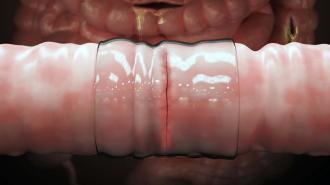MIT engineers have developed a biodegradable surgical tape that can be applied to tears in the gastrointestinal (GI) tract as easily as duct tape around leaky pipes.
Gut check: The GI tract is about 30 feet long and contains the major organs of the digestive system, including the colon, stomach, and intestines.
Certain health issues, such as colitis, can cause tears in the GI tract, as can physical trauma, such as accidents, gunshots, or knife wounds. Surgeons sometimes need to remove segments of the GI tract to treat diseases, such as colon cancer, too.
“Surgeons could use it as they use duct tape in the nonsurgical world.”
Hyunwoo Yuk
The challenge: It’s incredibly important that the GI tract be properly sealed following any tear or surgery — if it isn’t, bacteria can leak into the abdominal cavity and cause life-threatening sepsis.
Ensuring a tight seal isn’t easy, though. Surgeons must take care to precisely suture the wound, and because the tissue is so soft, it can still tear between perfectly positioned stitches.
“There are millions of surgeries worldwide a year to repair gastrointestinal defects, and the leakage rate is up to 20 percent in high-risk patients,” project supervisor Xuanhe Zhao told MIT News.
The idea: In the hope of lowering that rate, the MIT team turned a double-sided surgical tape it had developed in 2019 into a clear, single-sided tape that could be placed over sutures or used instead of them during GI repair operations.
“We thought, maybe we could turn our sticky element into a product to repair gut leaks, similar to sealing pipes with duct tape,” lead author Jingjing Wu said.
“It doesn’t need any preparation or prior step. Just take it out, open, and use.”
Hyunwoo Yuk
Seal of approval: After determining through lab experiments that the surgical tape was biocompatible with human cells, the MIT team moved on to animal studies.
When they tested the tape in rats, they found that it formed a seal over colon and stomach tears in less than 10 seconds after application and remained in place throughout the healing process.
Pigs whose colon defects were patched using the surgical tape, meanwhile, had no health issues during the four-week healing process — they ate normally, didn’t appear lethargic, and displayed fully healed defects with no signs of leakage at the end of the month.
Looking ahead: The researchers have now founded a company, SanaHeal, to develop the tape for use in hospital operating rooms.
“We think this surgical tape is a good base technology to be made into an actual, off-the-shelf product,” co-lead author Hyunwoo Yuk said. “Surgeons could use it as they use duct tape in the nonsurgical world. It doesn’t need any preparation or prior step. Just take it out, open, and use.”
We’d love to hear from you! If you have a comment about this article or if you have a tip for a future Freethink story, please email us at [email protected].






